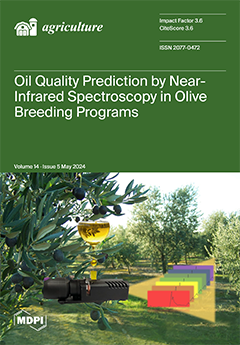The BTB (broad-complex, tramtrack, and bric-à-brac) domain, also known as the POZ (POX virus and zinc finger) domain, is a conserved protein–protein interaction domain present in various organisms. In this study, we conducted a genome-wide search to identify and characterize
BTB genes in
[...] Read more.
The BTB (broad-complex, tramtrack, and bric-à-brac) domain, also known as the POZ (POX virus and zinc finger) domain, is a conserved protein–protein interaction domain present in various organisms. In this study, we conducted a genome-wide search to identify and characterize
BTB genes in
Solanum tuberosum. A total of 57
StBTBs were identified and analyzed for their physicochemical properties, chromosomal distribution, gene structure, conserved motifs, phylogenetic relationships, tissue-specific expression patterns, and responses to hormonal and stress treatments. We found that
StBTBs were unevenly distributed across potato chromosomes and exhibited diverse gene structures and conserved motifs. Tissue-specific expression analysis revealed differential expression patterns across various potato tissues, implying their roles in plant growth and development. Furthermore, differential expression analysis under hormonal and stress treatments indicated the involvement of
StBTBs in abiotic and biotic stress responses and hormone signaling pathways. Protein–protein interaction analysis identified potential interactions with ribosomal proteins, suggesting roles in translational regulation. Additionally, microRNA target site analysis revealed regulatory relationships between
StBTBs and miRNAs. Our study provides a comprehensive understanding of the
StBTB gene family in potato, laying the groundwork for further functional characterization and manipulation of these genes to improve stress tolerance and agricultural productivity in potato and related plant species.
Full article





